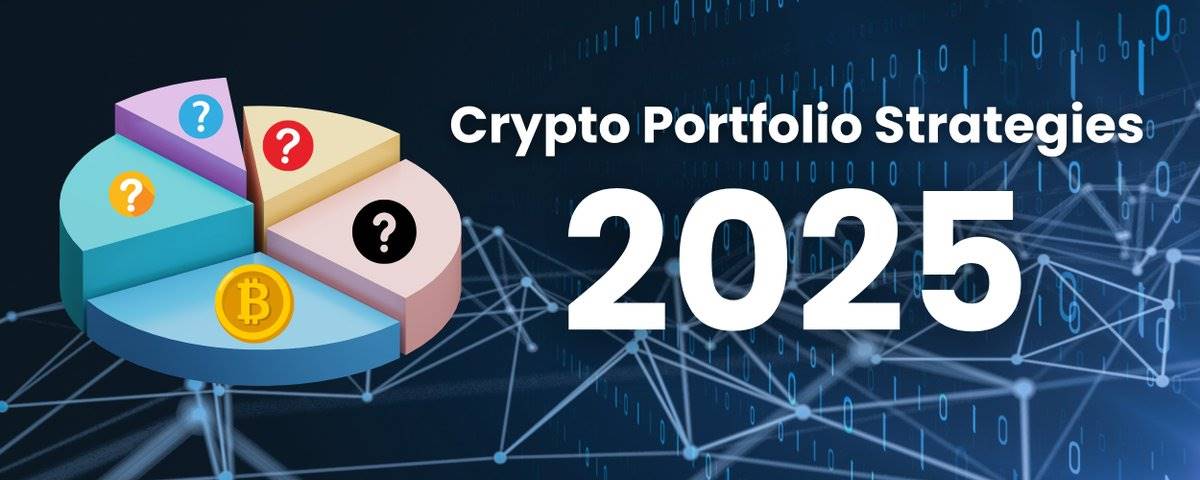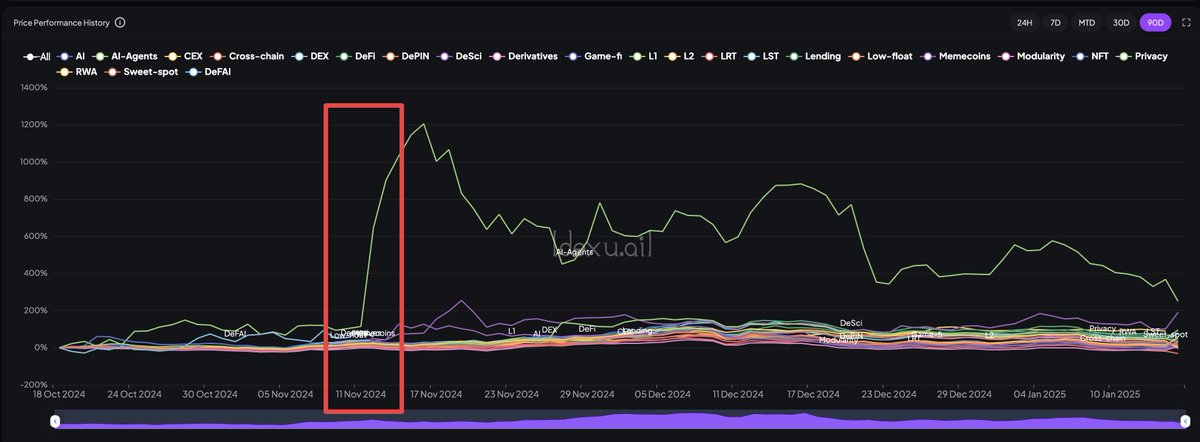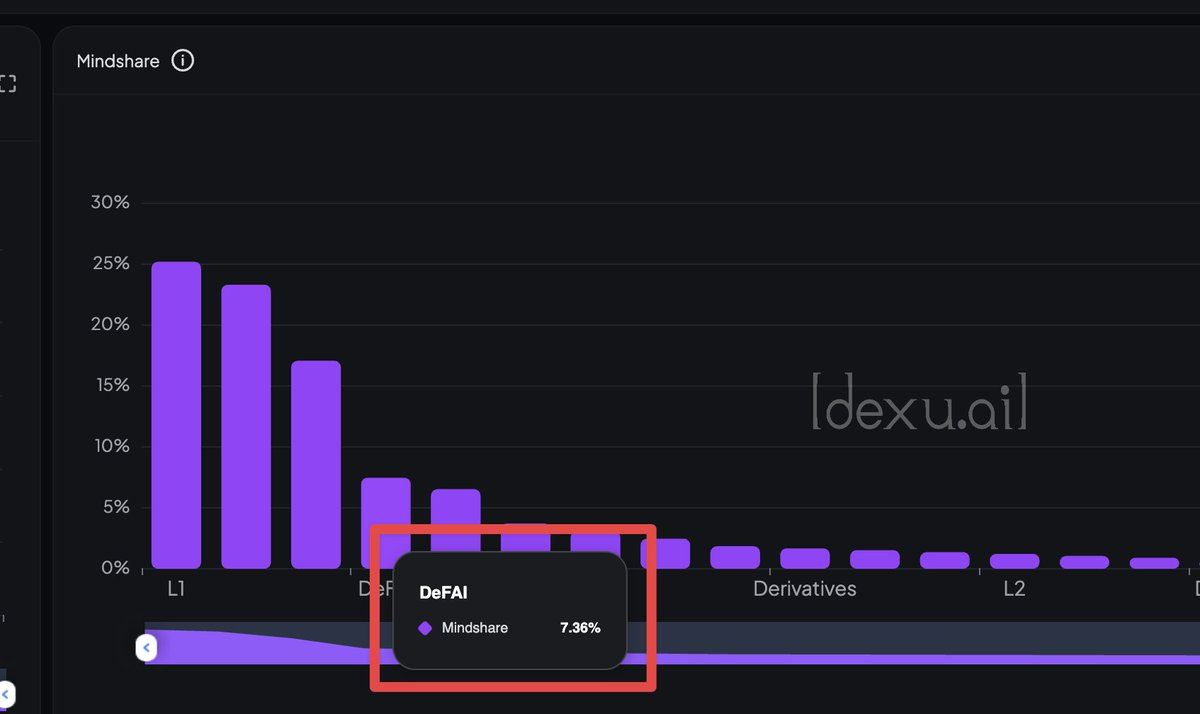Help you find an investment method that suits you.
Author: Edgy - The DeFi Edge
Compiled by: Deep Tide TechFlow

The goal of this cycle is to achieve life-changing returns.
If you want to achieve life-changing returns in this cycle, you need to build your investment portfolio correctly. However, the performance of this cycle has differed from our expectations. The price of ETH has remained almost stable around $3200, and a comprehensive altseason has not yet occurred as it did in the past.
Even more surprisingly, new investment trends emerge in the market every few weeks. If you have been holding Goat or Zerebro (pioneers in the AI field) since last October, your current performance may be below the market average.
Therefore, adapting to market changes is crucial.
The new year is a great opportunity to reassess and adjust your portfolio. I want to share how I plan my investment strategy, hoping to help you find a method that suits you. For me, dividing the portfolio into different "buckets" is a very effective way to better manage risk while clarifying each goal.
It is important to note that I will not provide specific allocation ratios. Everyone's goals and risk tolerance are different. For example, small-scale investors may be more inclined to take risks, while large-scale investors may focus more on conservative strategies.
What I share is a strategic framework to help you find an investment method that suits you.
First Bucket: Long-term Reserves

Examples: Bitcoin, Ethereum, Solana
Goal: Achieve wealth growth through long-term holding and hedge against the risk of fiat currency depreciation. This portion of funds is to ensure that you can steadily profit over a sufficiently long period. Regardless of market fluctuations, these tokens are core assets held across multiple cycles, and each cycle will make this investment bucket larger.
I consider this portion of funds as "untouchable" reserves. Funds will flow into this investment bucket in every cycle, but there will never be funds flowing out. All profits will ultimately enter this investment bucket.
In a bull market, you may feel FOMO. When you hear about a new token with huge potential but find you have no extra funds, you might consider tapping into the reserves in this bucket:
"I'll sell some Bitcoin and jump into this new coin. Once this coin rises 10 times, I'll buy back Bitcoin!"
Such plans are often hard to realize. Even if you do make a 10x profit, you might feel like a genius and continue to take risks until you eventually return the funds to the market.
The core task of this portion of funds is defense. No matter what happens in life, I will never start from zero. The value of Bitcoin may reach $1 million in the future. You definitely don't want to regret selling Bitcoin to chase after those ultimately worthless junk coins.
In the past, I allocated Bitcoin and Ethereum equally in this investment bucket. But later I changed my strategy and now lean more towards Bitcoin. The reason is simple: Bitcoin, as digital gold, is irreplaceable, while Ethereum faces challenges from multiple directions in every cycle. It not only competes with other smart contract platforms but also needs to solve its scalability issues and complex ecosystem.
Most of the reserve funds are stored in cold wallets, and I also allocate about 30% of the funds for DeFi yields and potential airdrops. For example, I earn yields on BTC through @SolvProtocol while seeking airdrop opportunities. My ETH is used as $mETH for liquidity mining on @0xMantle.
Measure of Success: At the end of each market cycle, I measure my investment effectiveness by the growth scale of this investment bucket. The goal is clear: continuously accumulate Bitcoin and prepare for the future.
Second Bucket: Cyclical Belief Holdings
Examples: Virtuals, Hyperliquid, Solana, Sui, Pendle, etc.
Goal: Choose assets you truly believe in. Many people lose money due to frequent trading and excessive rotation, and the focus of this portion of the portfolio is long-term holding to avoid these issues.
These assets are your most confident choices; even if the price drops by 25%, you won't waver. They are usually the core assets of the hottest narratives in each cycle.
Start positioning early in the cycle, hold these assets throughout the cycle, and gradually take profits as prices rise. Completely exit these positions before a bear market arrives, and then look for re-entry opportunities during the bear market.
It is important to note that adjusting strategies is normal. I originally listed ai16z as one of my long-term holdings for this cycle, but recently I decided to liquidate it, even though it was supposed to be a long-term asset. The reason is simple: I no longer want to deal with the unpredictable behavior of the founder.
The key is: maintain strong beliefs but be flexible in response to changes.
Third Bucket: Short-term Trading
Goal: Short-term trading is your main source of high returns, but it also comes with significant volatility. Focusing on the hottest areas in the market is key to success.
Currently, I do not believe there will be a comprehensive altcoin market where all assets rise simultaneously. The reason is that there are too many types of tokens in the market, and liquidity is insufficient. This phenomenon is referred to as "altcoin dispersion."
Therefore, it is particularly important to choose the hottest areas in the market. In this cycle, we have already seen strong performances from memecoins and A.I. agents.
My approach is as follows:
Identify 1-2 of the strongest performing areas;
Find the most promising projects within these areas;
Transfer profits to BTC or stablecoins to lock in gains.
How to find hot areas? To be honest, experienced investors can usually sense trends through the market "atmosphere." However, there are now some tools that can help us quantify these trends.
For example, @kaitoai is a paid tool, while @dexuai is free and very efficient.

From the data, it can be seen that A.I. agents have been performing well since November 11, 2024. You don't need to enter the market as soon as the trend emerges; just act decisively when market signals are clear.
Some may question: "Aren't these A.I. agents just a rebranding of ChatGPT?"
Maybe so, maybe not.
But as long as the market is willing to bring me returns, I will seize the opportunity rather than waste time on social media opposing for the sake of opposing.
You can think of understanding industry development as surfing. I am always looking for bigger waves, ready to catch the next opportunity.
For example, I have always believed that A.I. agents will fundamentally change DeFi. This is because the learning curve of DeFi is too steep, and the user experience (UX/UI) is very unfriendly.
In the past few months, I chose to invest in the MODE network because they have a unique advantage in this field. They had already conducted in-depth exploration in this direction long before DeFAI (the combination of DeFi and AI) became a hot topic.
However, my investment logic is loyal to trends, not to specific protocols—my goal is to find the fastest "horse" in each field.
When @DanieleSesta launched @HeyAnonai, I judged that this was a faster "horse," so I decisively adjusted my portfolio.
Why did I do this? Because in the last market cycle, I witnessed him successfully push two protocols to a $1 billion market cap. He not only has an extraordinary ability to drive protocol value but also demonstrates an uncompromising competitive spirit, which makes him a strong contender worth watching.
(It should be noted that I have no intention of making any negative comments about the MODE network. I believe their development progress is ahead of most DeFAI projects and may perform better in the future. But I hope to share these stories to make this article not just theoretical.)
In the cryptocurrency field, the key to making money is not what you think will rise, but what you judge others will think will rise. This is the core idea of the "Keynesian Beauty Contest"—the collective expectations of the market are the key to determining prices.
From the chart below, it can be seen that DeFAI is gradually gaining market attention. Therefore, I believe this narrative has great potential and is worth continuing to follow and explore.

In short-term trading, I usually focus on the following key points:
Maintain a high level of attention to emerging fields. I am always interested in new categories, which is why AI agents are so captivating. Currently, new use cases for AI are emerging one after another, making it almost impossible to accurately assess their value. For example, the combination of AI agents with the metaverse, or an AI tool specifically designed to find system vulnerabilities.
As of January 15, 2025, DeFAI (the combination of DeFi and AI) is a brand new field. If greater opportunities arise in the coming months, I will decisively adjust my strategy to catch that wave.
The importance of rapid iteration. In the crypto space, user attention is extremely fleeting, even likened to "goldfish memory." Therefore, the speed of team updates is crucial. The ability to iterate quickly is key for a protocol to maintain market attention.
To stick to beliefs or chase trends? Simply put, trading can be divided into two styles:
The first is belief-based trading. You conduct in-depth research, position yourself early, and build confidence in a project. Then, you wait for other market investors to gradually discover this opportunity. This is also my strategy with the GAME project. I bought it early and patiently held it for several weeks until its price began to explode.
However, this approach also carries risks. When the price remains stagnant for a long time, you may start to doubt whether you are a visionary genius or a "fool" misjudging the situation.
The second is to chase market momentum. When a project suddenly explodes, you quickly follow the trend and ride the wave. This method is equally effective. Both have their advantages, and the key is to find a strategy that suits you. Keeping a trading journal can be very helpful in this process. Through long-term data accumulation, you can identify your trading patterns and summarize the conditions under which you are more likely to succeed.
Finally, you need to figure out which areas you excel in when it comes to investing. I don't like spending time in the "bottom trenches" digging up projects with a market cap of less than $1 million; that doesn't suit me.
From my experience, my most successful strategy is to find protocols with a market cap between $5 million and $25 million, then hold them until their market cap exceeds $100 million. This is my way, but everyone's strengths are different. Perhaps you have more insights in those higher-risk, higher-reward "Degen" (speculative) investments.
In trading, I follow these principles:
I will cut losses early.
I usually take profits when returns reach around 3 times.
If a project performs exceptionally well, I will increase my investment in it.
Fourth Bucket: Stablecoins
Stablecoins play an important role in the portfolio, mainly serving the following purposes:
Reduce volatility: Stablecoins can help stabilize your portfolio. After all, if you invest entirely in high-risk tokens, a 40% drop in assets within a day is hard to bear. Stablecoins allow you to stay calm during market fluctuations and continue participating in the game.
Provide "ammunition" for bottom fishing: Looking back at past bull markets, the market has never risen continuously; there are always opportunities for pullbacks. Having stablecoins on hand allows you to seize these opportunities.
Earn yields: Currently, the annual percentage yield (APY) for stablecoins is around 15-20%, which can accumulate into a significant income. I personally recommend @0xfluid as a yield tool.
I categorize stablecoins into two types:
Permanent yields: This portion consists of stablecoins I have extracted from the market, planning to permanently exit the crypto market. They can be used for yield farming or directly exchanged for fiat currency. This ensures that you won't give back all your profits in a single cycle.
Temporary yields: This portion consists of funds temporarily stored after profiting from certain assets, waiting to find new investment opportunities. For easier management, different stablecoins can be used to distinguish them, such as storing permanent yields as USDC and temporary yields as USDT, or transferring all permanent yields to Fluid.
Diversification is key: In the last cycle, we all witnessed some unexpected events with stablecoins, so it is very important to hold different types of stablecoins (such as USDC, USDT, sUSD, and even some asset-backed stablecoins) in a diversified manner. Additionally, spreading them across different yield platforms can also reduce risk.
Other Suggestions
- "Put all your eggs in one basket, but watch that basket closely." This phrase can be interpreted in various ways. I am not concentrating all my funds in one protocol; rather, I am currently focusing my main efforts on the field of AI agents.
Moreover, every time I see someone talk about "buying the dip" while simultaneously investing in more than 25 protocols, I find it amusing. You need to have genuine belief in a particular direction. Otherwise, even if you hit on a project, the overall asset enhancement will be minimal.
I believe holding 5-7 tokens is the optimal strategy. When I choose a token, I go all in: actively participating in its Discord or Telegram groups, keeping an eye on protocol, founder, and team updates, and listening to all relevant podcasts.
If you hold more than 15 tokens, it becomes difficult to conduct in-depth research on each project. This may also indicate a lack of confidence in your investments.
- Do not ignore market trends. My greatest successes often come from decisively entering the market when token prices begin to soar. Winners tend to keep winning. So, how do you determine if you are just a "bag holder"? It's actually quite simple.
Ask yourself whether your reason for buying was fear of missing out (FOMO) or influenced by a key opinion leader (KOL), or if it was based on thorough research and building your own conviction. Does the protocol have sufficient progress and catalysts to continue attracting market attention?
- The speed of market rotation is extremely fast. Nowadays, first-mover advantages are not as strong as they used to be. For example, GOAT and Zerebro initially held market advantages but eventually lost their leading positions. If a protocol has a first-mover advantage, you need to assess whether its advantages are "sticky" enough. Is its moat strong enough?
Take AIXBT as an example; it indeed has a first-mover advantage, but its market penetration and user mindshare far exceed other Alpha bots. I greatly appreciate that most of their technology is developed in-house, making it harder for competitors to replicate their results and seize market share.
Design your portfolio for a bear market. Clarify your investment goals, then achieve them through "reverse engineering." For example, you might choose 30% Bitcoin (BTC) and 70% stablecoins. Regardless, you must gradually lock in profits as the market rises.
Reassess your portfolio. Your portfolio may be filled with ineffective assets, such as some "moonbags" or tokens you have emotional attachments to. Ask yourself, if you were to build your portfolio from scratch, what would it look like?
Remember, continuing to hold an asset is essentially equivalent to buying it again every day.
- "When to convert cryptocurrency into fiat?" When you need to. I don't often convert cryptocurrency into fiat currency, usually only when I need to pay taxes or when my crypto assets are disproportionately high compared to traditional financial (TradFi) assets.
My goal is to have crypto assets continuously generate income for me. I try to maintain a low cost of living, and my company (The DeFi Edge) pays me a fixed salary each month. Therefore, I do not easily interrupt the compounding growth of my assets.
My goal is to have crypto assets continuously generate income for me. I maintain a low cost of living and receive a monthly salary from my company (The DeFi Edge), trying not to interrupt the process of compounding growth.
That’s all my sharing. If you are interested in certain topics and want to know more, please let me know, and I can write more detailed articles.
Thank you for reading!
免责声明:本文章仅代表作者个人观点,不代表本平台的立场和观点。本文章仅供信息分享,不构成对任何人的任何投资建议。用户与作者之间的任何争议,与本平台无关。如网页中刊载的文章或图片涉及侵权,请提供相关的权利证明和身份证明发送邮件到support@aicoin.com,本平台相关工作人员将会进行核查。



